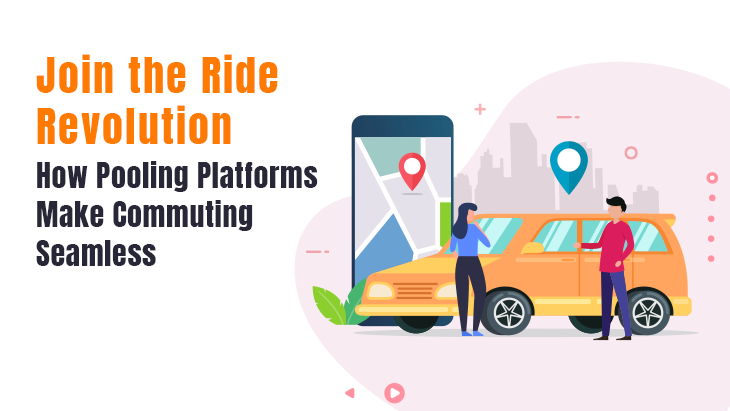Join the Ride Revolution: How Pooling Platforms Make Commuting Seamless

Commuting is just a fact of life for millions of people around the world. For most, it has become an inevitable part of daily life to get to work, run errands, or drop off the kids at school with Trip Tie. Still, sometimes commuting appears to be so difficult traffic jams, expensive fuel prices, the concerns of the environment, and sheer frustration that someone spends hours behind the steering wheel every week. But what if the answer came, changing the situation? Looking in that direction are the ride-pooling platforms a revolutionizing concept changing the way one thinks about commuting.
The Revolution The Stride to Commuting
Commuting has often been defined as involving single-passenger vehicles for decades. People are driving alone in their cars, listening to the radio or podcasts, or staring at the tail lights of the car in front. Although revolutionary in many regards, the growth of automobile use has resulted in disastrous traffic jamming, pollution, and underutilization of resources. Often, only one individual was traveling in each car on the road, which resulted in tremendous fuel waste, time waste, and energy waste.
As cities get more populous, the desire for a green, efficient, and practical means to travel from point A to point B has emerged. Ride-sharing platforms like Uber and Lyft are changing how people think about car ownership and even public transportation. But even these services primarily focus on individual trips rather than pool rides.
Enter ride pooling.
What is ride pooling?
Ride pooling refers to a transport mode wherein several passengers share the same vehicle while traveling along similar routes. It is straightforward: people travel to a point with other people who have the same destination or even commuting route instead of going alone or spending too much on a single ride; sharing it and splitting the cost can reduce the number of cars on the roads.
Ride pooling today is as sophisticated as it could ever be because of the number of tech-driven platforms that have made it easier, faster, and more reliable than ever. While apps match drivers with passengers and services that allow you to book a ride beforehand, ride pooling is revolutionizing the urban commute: not only cheaper and greener but also more social.
How Do Ride Pooling Platforms Work?
Technology innovates how ride pooling nowadays connects commuters to other people going in the same direction. Apps such as Lyft Line, UberPool, and regional ride-sharing services will use algorithms to determine the most efficient route for carpooling. When you're requesting a ride, the app first checks if other riders have traveled along a similar route and adjust the driver's path to pick up or drop off passengers on the way.
Where shared rides are preferred over other taxi services or platforms for ride-hailing. The route of the driver may even be modified a little bit by the platform to accommodate some more passengers. By so doing, it provides an experience that does not only cut down on your carbon footprint but also proves to be more cost-effective and, in most cases, pleasurable than traveling alone.
Advantages of Ride Pooling Economic Advantages
Cost Saving
The most apparent advantage of ride-pooling platforms is cost savings. Riding with others enables you to split the cost of fuel and driver fees. Generally, based on your locale, a ride-pooling service may save a commuter 30% to 50% compared with taking an individual ride. Many companies offer subscription services or special discounts to frequent riders, so it makes it much cheaper.
Environmental Impact
The environmental benefits, above all, stand out as the most persuasive argument for ride pooling. Fewer cars on roads means fewer pollutants in the air and a smaller carbon footprint. A study conducted by the Environmental Defense Fund reports that if 10% of U.S. commuters use carpooling, this would be equivalent to taking more than 7 million cars off the road, which means a serious reduction in traffic congestion and lowers overall emissions. Taking a ride-share approach is not only saving you money but also ensuring cleaner and more sustainable urban spaces.
Less Traffic Congestion
Heavy traffic congestion is among some of the major contributors to the stress experienced by commuters. Long traffic jams that dot almost every city in the world are so common and a part of our lives. This condition can be trimmed if people embrace ride-pooling. This means fewer cars on the road, less gridlock, increased travel time, and an overall better system of transportation.
Convenience and Flexibility
And with smartphone apps, booking a ride pool has never been easier. Whether one wants to be picked up at the doorstep or intends to meet at a given drop-off point, these platforms offer flexibility in getting from one place to another that is often not found with regular public transportation.
Convenience and Flexibility
Several services also run round-the-clock, offering on-demand rides to night-shift workers, night commuters, or others with unpredictable schedules.
Community and Social Interaction
However, while commuting, sometimes one can be in a pretty isolated process. However, ride pooling is oftentimes a totally different experience altogether since one can meet new people, start conversations, and start experiences along the way. For those people who entertain a little bit of social interaction during their commutes, ride pooling can become a truly enjoyable and enriching experience.
Challenges and Considerations
While ride-pooling has many advantages, let's take a look at some of the disadvantages of such transportation. For example, most people fear that with more passengers getting in and out, the waiting time for them would increase, and their distance traveled would be longer than it was destined to be. This is because ride pooling services aim to conserve routes, but passengers probably still suffer delays relative to the journey taken in a direct, single-occupancy ride.
There is another factor which is privacy. Since you are going to share a ride with strangers, the passengers may feel uncomfortable due to their unavailability of personal space or the unpredictability of the other fellow riders. These concerns are handled by most platforms through the implementation of features like safety in real-time tracking, driver and rider ratings, and in-app communication systems.
For a system to be effective, there also needs to be an adequate pool of users in a given area. Ride pooling services may not be very viable in cities with fewer commuters or in suburban and rural areas, simply because fewer people are available to share rides.
The Future of Ride Pooling
As cities continue to grow and new demands for more sustainable solutions for transportation keep arising, ride pooling will probably be of significant importance for urban mobility. Indeed, tech companies will improve their algorithms to better match passengers and drivers in real time, optimize routes to save time and energy and help pollute less.
But ride pooling itself can take the form of an even smoother and more efficient service when EVs, autonomous cars, and shared vehicle fleets are developed. Imagine entering an electric car or a self-driving ride pool, where a person does not exist to drive the car, and the entire car adjusts itself to the needs of all its passengers.
Conclusion
Ride pooling is not just a fad, but a real revolution in transportation that is making commuting more convenient, cost-effective, and sustainable. Amid the accelerated urbanization of the world, pool platforms offer the most straightforward solution to this era's greatest modern conundrums: traffic congestion, high costs, and environmental degradation. By sharing a ride, you save more than just money and hours; you're helping build smarter, greener cities for everyone. So whether it is to save on fuel, reduce carbon footprints, or simply meet new people, there's an easy way forward with ride pooling.

